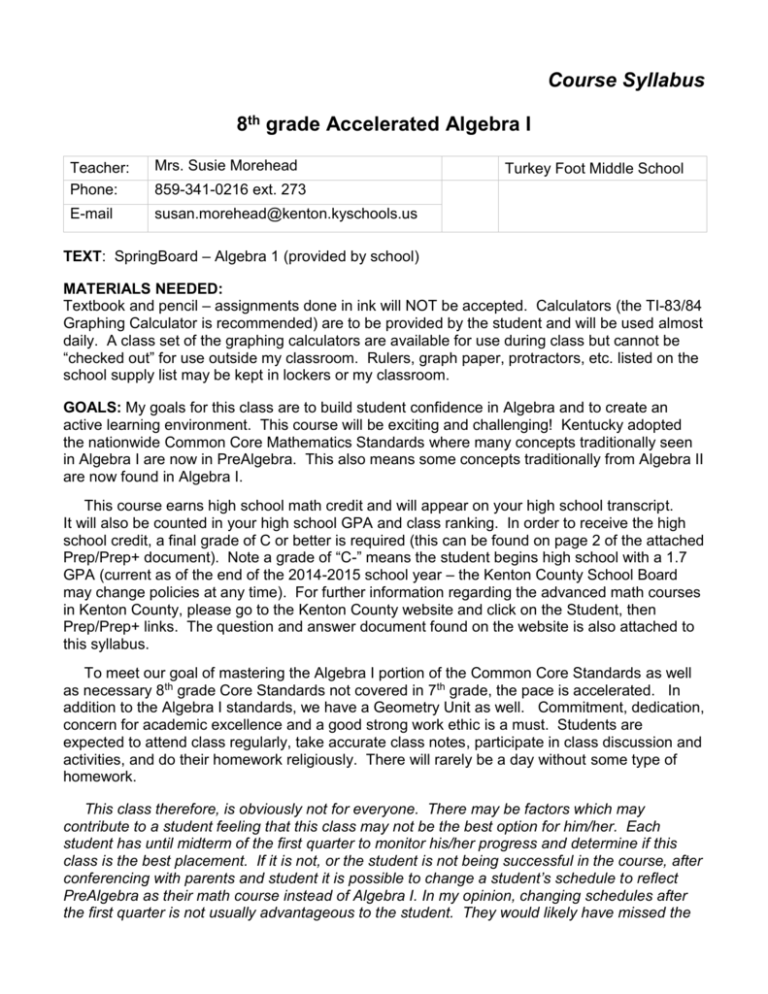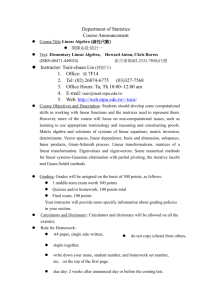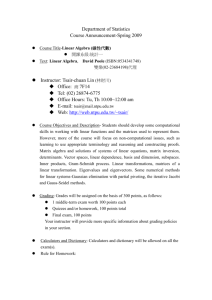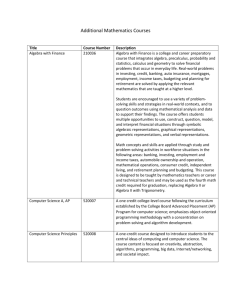2015-2016 Algebra course syllabus
advertisement

Course Syllabus 8th grade Accelerated Algebra I Teacher: Phone: Mrs. Susie Morehead E-mail susan.morehead@kenton.kyschools.us Turkey Foot Middle School 859-341-0216 ext. 273 TEXT: SpringBoard – Algebra 1 (provided by school) MATERIALS NEEDED: Textbook and pencil – assignments done in ink will NOT be accepted. Calculators (the TI-83/84 Graphing Calculator is recommended) are to be provided by the student and will be used almost daily. A class set of the graphing calculators are available for use during class but cannot be “checked out” for use outside my classroom. Rulers, graph paper, protractors, etc. listed on the school supply list may be kept in lockers or my classroom. GOALS: My goals for this class are to build student confidence in Algebra and to create an active learning environment. This course will be exciting and challenging! Kentucky adopted the nationwide Common Core Mathematics Standards where many concepts traditionally seen in Algebra I are now in PreAlgebra. This also means some concepts traditionally from Algebra II are now found in Algebra I. This course earns high school math credit and will appear on your high school transcript. It will also be counted in your high school GPA and class ranking. In order to receive the high school credit, a final grade of C or better is required (this can be found on page 2 of the attached Prep/Prep+ document). Note a grade of “C-” means the student begins high school with a 1.7 GPA (current as of the end of the 2014-2015 school year – the Kenton County School Board may change policies at any time). For further information regarding the advanced math courses in Kenton County, please go to the Kenton County website and click on the Student, then Prep/Prep+ links. The question and answer document found on the website is also attached to this syllabus. To meet our goal of mastering the Algebra I portion of the Common Core Standards as well as necessary 8th grade Core Standards not covered in 7th grade, the pace is accelerated. In addition to the Algebra I standards, we have a Geometry Unit as well. Commitment, dedication, concern for academic excellence and a good strong work ethic is a must. Students are expected to attend class regularly, take accurate class notes, participate in class discussion and activities, and do their homework religiously. There will rarely be a day without some type of homework. This class therefore, is obviously not for everyone. There may be factors which may contribute to a student feeling that this class may not be the best option for him/her. Each student has until midterm of the first quarter to monitor his/her progress and determine if this class is the best placement. If it is not, or the student is not being successful in the course, after conferencing with parents and student it is possible to change a student’s schedule to reflect PreAlgebra as their math course instead of Algebra I. In my opinion, changing schedules after the first quarter is not usually advantageous to the student. They would likely have missed the Course Syllabus (cont.) “building” content in the PreAlgebra course that would be necessary to master the concepts with which they had been struggling in the Algebra I course. There is not much review or repetition of previous year’s content once students are in the PreAlgebra course. EVALUATION: I assign two types of assignments, although all are based on points earned divided by points possible. One type is a completion grade, usually worth 10 points. If a student has attempted all problems, 10 points are given. These type of assignments are normally given on the day a topic is introduced. The other type is an accuracy grade (number correct divided by the number possible and one point per problem). So as you can see, every assignment will “count” although not all are collected. Quiz problems are generally worth two points each. Tests count as double grades, and at least one review day precedes a unit test. At the end of the course, a comprehensive final exam is given. Because the completion grades naturally boost averages, I rarely, if ever, give extra credit. TOPICS: Unit 1: Students are introduced to fundamental concepts necessary for success in algebra by recognizing and generalizing patterns using words, tables, expressions, and graphs. Students will also generate rules for solving simple linear equations and inequalities as well as absolute value equations. Unit 2: In this unit, students study functions and function concepts including domain, range, slope as a rate of change, and intercepts. Students will write linear functions given a point and a slope, two points, a table of values, an arithmetic sequence or a graph. We will also collect and model date with linear, quadratic or exponential functions. Unit 3: This unit continues the study of linear concepts by learning about piecewise-defined linear functions, linear inequalities with one and two variables, and systems of linear equations and inequalities. At this point we will break from the Algebra I SpringBoard book to complete a Geometry Unit. This is not high school Geometry, but the 8th grade Common Core Geometry Math Standards that are covered in the PreAlgebra course textbook. Students will be given a copy of the unit. Since there is not much overlap between courses, students in the Prep/Prep+ track would not be given the opportunity to learn these standards without breaking from the Algebra text. Unit 4: In this unit we will explore representations of nonlinear data. Exponential growth and decay, properties of powers and radical expressions are main concepts. We will also perform operations with radical and rational expressions. Unit 5: In this unit we will student a variety of ways to solve quadratic functions and apply the knowledge to real world problems. Once these units are completed, the district-wide Algebra 1 Comprehensive End of Course Exam is given. This exam grade along with the student’s four quarter grades are averaged together (the exam counting as 1/5 or 20%) for the final Algebra 1 average, therefore determining their GPA. Page 2









